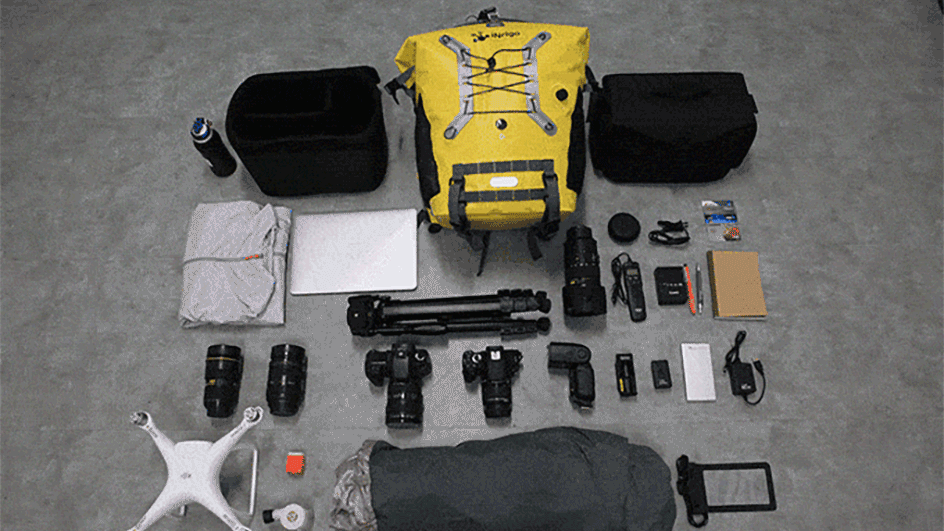
Feb 8, 2019
By Kelsey Brannan (aka Premiere Gal)
As a videographer, we never want to check a bag of equipment when we travel. Why? Well, your baggage could get lost or something could get damaged under the plane — and that’s a travel vlogger’s worst nightmare!
So really our only option is to do our best to take all the essential video equipment as a carry-on. This means we have to be wise about what we bring due to strict carry-on weight and size requirements.
I recently travelled to Corfu, Greece, with 19 lb. (8.6 kg) of video equipment all in one backpack. Here is what I brought and why I recommend it:
A Versatile And Waterproof Backpack
The key to a great camera gear backpack is that it can hold everything you need.
In my recent trip to Greece, I brought with me the Inrigo Smart waterproof backpack. It can hold up to 30 liters of space and you can take it with you outdoors and it will protect all your equipment from water.
It will also notify you with an app if your backpack is too hot or humid for your equipment.
- $299 Inrigo Smart Waterproof Backpack (4 lb.)
- Go here to explore budget camera backpacks
Ultra-compact Fluid Head Video Tripod
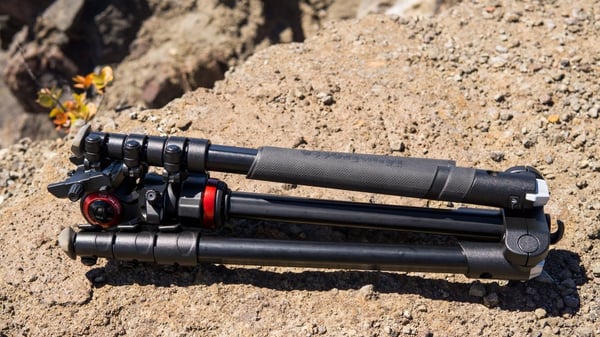
When you are traveling, you don’t want to bring a huge and bulky tripod with you. Manfrotto recently released a brand-new ultra-compact aluminum tripod designed specifically for travel videography. And it weighs less than 1 pound!
- $199 Manfrotto Befree Live Video Ultra Compact Video Tripod (0.8 lb.)
A Mirrorless Camera
Over the past two years, mirrorless cameras have become more popular than the standard DSLR. Why? Because of weight! They are much lighter and less bulky — so it’s easy to travel with.
While many vloggers would say they prefer Sony mirrorless cameras, I use a Canon EOS M3 for all of my video production in the studio and while I travel.
I chose the camera mainly for it’s value at a low price. Right now the camera is under $400 and shoots 1080p HD /30fps. It also includes a microphone jack, manual and auto-focus (touch-screen focus), and a flip up selfie screen for vlogging.
In May of this year, Canon also released a new Canon M50 which now has a viewfinder and shoots 4k at 30fps.
- $349.95 (Budget Option) Canon EOS M3 (1.1 lb.)
- Shoots up to 1080p, LCD flips up selfie style
- Optional: $19.95 easyCover silicone protection for Canon M3
- $700 Canon EOS M50 (1.1 lb.)
- Shoots 4k and LCD screen flips out to the right, rather than up
Interchangeable Lenses
Mirrorless cameras work just like DSLR cameras and they support interchangeable lenses. If you are primarily vlogging, I recommend bringing one solid wide-angle lens for most of your filming.
In order to use EF mount Canon lenses with a Canon Mirrorless, you need to also get a M to EF lens Adaptor.
- $59.95 Canon EOS M to EF Lens Adaptor (0.2 lb.)
- $279 Canon EF 10-18mm f/4.5-6.6 Wide Angle Lens for vlogging (0.5 lb.)
- Optional: $125 Canon EF 50mm f/1.8 for portraits and macro tripod shots (0.4 lb.)
Gorillapod
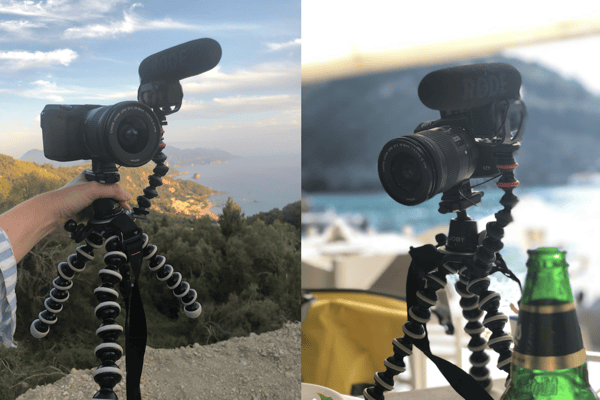
If you want to walk and talk to your camera with ease, or place your camera on a fence or hang it from a tree, the Joby GorillaPod is a must have.
Joby also released a new GorillaPod Rig which comes with two arms where you can also place a shotgun microphone and a light or attach another camera like a GoPro. The rig also comes with a carrying strap so you can easily carry your rig while on the go.
- $169 Joby GorillaPod Rig (1 lb.)
Compact Drone
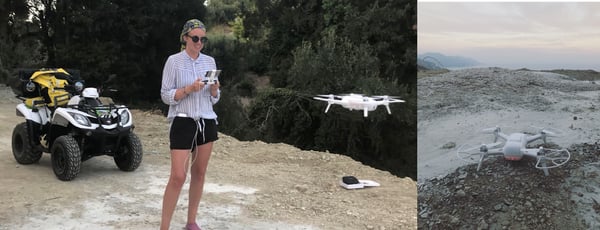
A travel vlog is no longer a vlog without some awesome aerial shots! Today, drone videography is easily accessible.
I currently own a Yuneec Breeze, which is a budget and compact drone that you can fly with your phone and controller. It comes with a selfie mode, orbit mode, and journey mode so the drone can follow you while you are on the go.
The batteries only last for about 12 minutes, so I recommend buying 3-4 for travel.
- $199 Yuneec Breeze for 4k video and 720p HD streaming (1 lb.)
- $300 DJI Spark for 1080p video (1.5 lb.)
Action Cameras
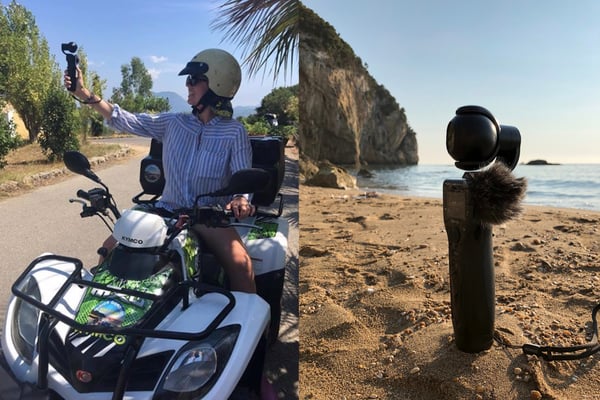
If you are going to be driving ATVS, sailing, or going underwater, you definitely want to have an action camera that you can bring with you during the more active part of your adventures.
On my trip to Greece I brought my Removu K1 all-in-one self stabilizing gimbal camera (get 5% off with the code "GAL5"). With Removu, I shot stable 4k video, slow motion, and timelapse shots on the move.
If you want to go under water, I’d recommend getting the GoPro Hero HD Waterproof Action camera. You can place the GoPro Hero on your Joby GorillaPog Rig for some awesome selfie shots or get the headmount for POV shots.
- $399 REMOVU K1 (0.8 lb.)
- $198 GoPro Hero HD Waterproof Action Camera (0.6 lb.)
- $19 GoPro Headstrap (0.2 lb.)
Memory Cards And Card Carrying Case
My Canon M3 takes SD cards and I like to take at least four 32 GB SD cards with me. Since action camera usually take microSD cards, I also take at least four 32 GB microSD cards with me as well.
- $34.50 SanDisk Extreme Pro 64 GB SD card (0.08 lb.)
- $19.89 SD, miniSD and microSD card carrying case (0.2 lb.)
Self-Reading Compact Hard Drive
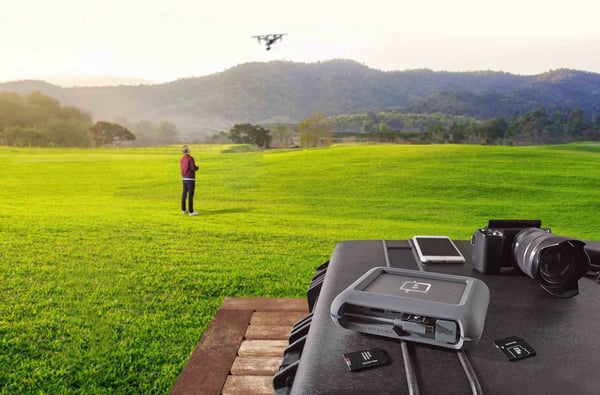
Earlier this year, LaCie partnered with DJI to create a computer free way of travel vloggers to backup their memory cards direct to a drive. They created “Copilot.” It’s a 2 TB portable drive that can read footage and charge your devices without a computer.
You can copy your files directly to copilot from cameras, drones, and USB devices via Copliot’s SD card slot and/or the USB port. You can view, playback, delete, or rename files by connecting Copilot to your phone with the cable that it comes with.
- $349 LaCie DJI COPILOT (1.2 lb.)
On-Camera Shotgun Mic
When vlogging, you can attach your shotgun to your mirrorless camera shoemount or attach it to one of the arms on your Joby GorillaPod rig. You can also use this mic to capture ambient sound from your travel, such as the waves crashing on the shore.
- $299 Rode VideoMic Pro Plus On-Camera Shotgun Mic (0.3 lb.)
Lav Mic Set (Optional)
If you plan on doing any interviews while you travel, it’s important to capture good audio.
The saramonic lav kit is an excellent budget option for you and I even use the kit to record myself talking, and the audio is much more direct and doesn’t pick up as much background noise as the on-camera Rode shotgun mic.
- $399 Saramonic 2 Lav Mic Kit (0.4 lb.)
Powerbank Charger
If you are out all day filming and taking photos it is likely that your phone will run out of battery. I recommend getting a portable power bank which you can charge at your hotel overnight and bring with you in case you need to give your iPhone an extra charge while on the go.
- $65 RAVpower Portable Charger (0.5 lb.)
Universal Adaptors, Chargers, and Rechargeable AA Batteries
When you are traveling, having extra batteries for your equipment is essential. I’d recommend having 4 batteries for your main camera, two extra batteries for your drone, and an 8-set of rechargeable double AA batteries for your lav mics.
- $12.99 Universal Travel Adaptor (0.1 lb.)
- $55.90 2x Yuneec Breeze Batteries (0.6 lb.)
- $19.99 2x Extra Canon Replacement Batteries (0.5 lb.)
- $18.39 Energizer 4xRechargeable AA batteries and Charger (0.6 lb.)
Accessory Pouch For Adaptors, Cables, Headphones, Etc.
Your cables and chargers can also turn into a mess! This is why I use a felt storage pouch to place all my cables, in-ear headphones, and adaptors.
- $10.99 Portable felt storage pouch (0.09 lb.)
A Laptop For Editing (Optional)
If you want to edit your video or photos while you travel to save time, I’d recommend the 15” MacBook Pro for speed and reliability.
Bringing the MacBook Pro though will add a significant weight to your load, this is why I suggested bringing the LaCie Copilot drive which can read and backup footage without the use of the computer.
- $3,889 Macbook Pro 15” 32GB Ram (4 lb.)
Total Weight: 19 lb./8.6 kg. (including option laptop and lav mic kit)
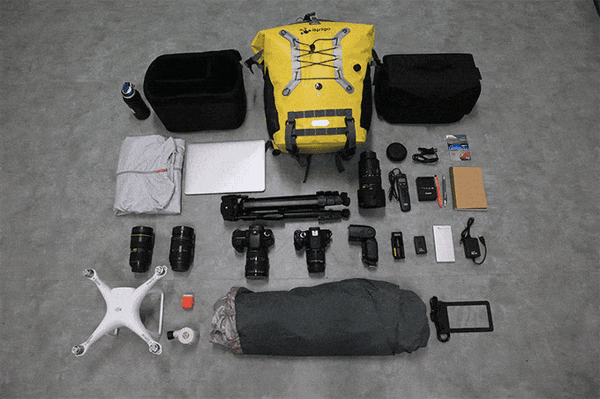
Final Travel Tips
- Check airline weight restrictions. Most U.S. domestic flights will not weigh carry-on backpacks unless it looks oversized in dimensions. For international flights, however, you can bring on a max carry-on weight of 13 lb. or 6 kg. Most international airlines will weigh your carry on at check in.
- Place less expensive items in checked-bag. If you need to remove weight from your carry-on backpack, I’d recommend moving lesser valuable items into your checked bag, such as the portable chargers, batteries and tripods. This will lessen your load and also take away any anxiety thoughts that the airline would want to check your backpack.
- Wear your backpack at the check-in counter. When I flew to Greece on a charter plane from Warsaw, Poland, they did not check my backpack weight. At the check in counter they weighed my checked bag which had my clothes and personal items. But since I had no carry-on roller bag, just a backpack on, the airline saw saw no issue. Little did they know, however, that my back had over 19 lb. in it! I passed through security and my iNrigo filled backpack fit perfectly on the overhead plane compartment with ease.
If you have any questions about this equipment or travel please leave a comment below or email me at contact@premieregal.com and I’ll be sure to help out! Be sure to also check out my YouTube channel, and happy traveling!